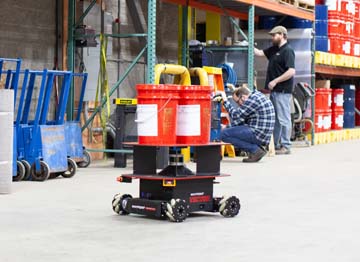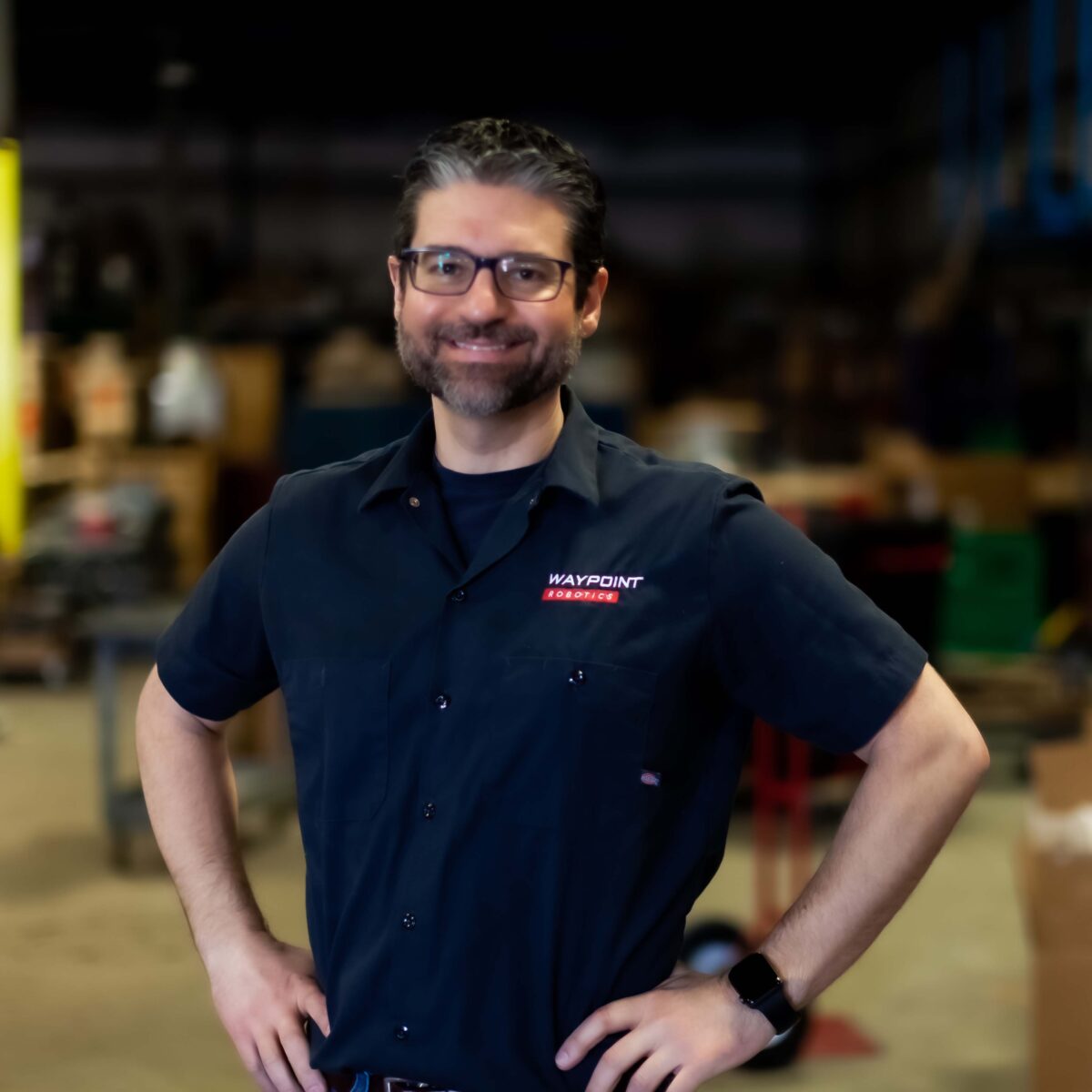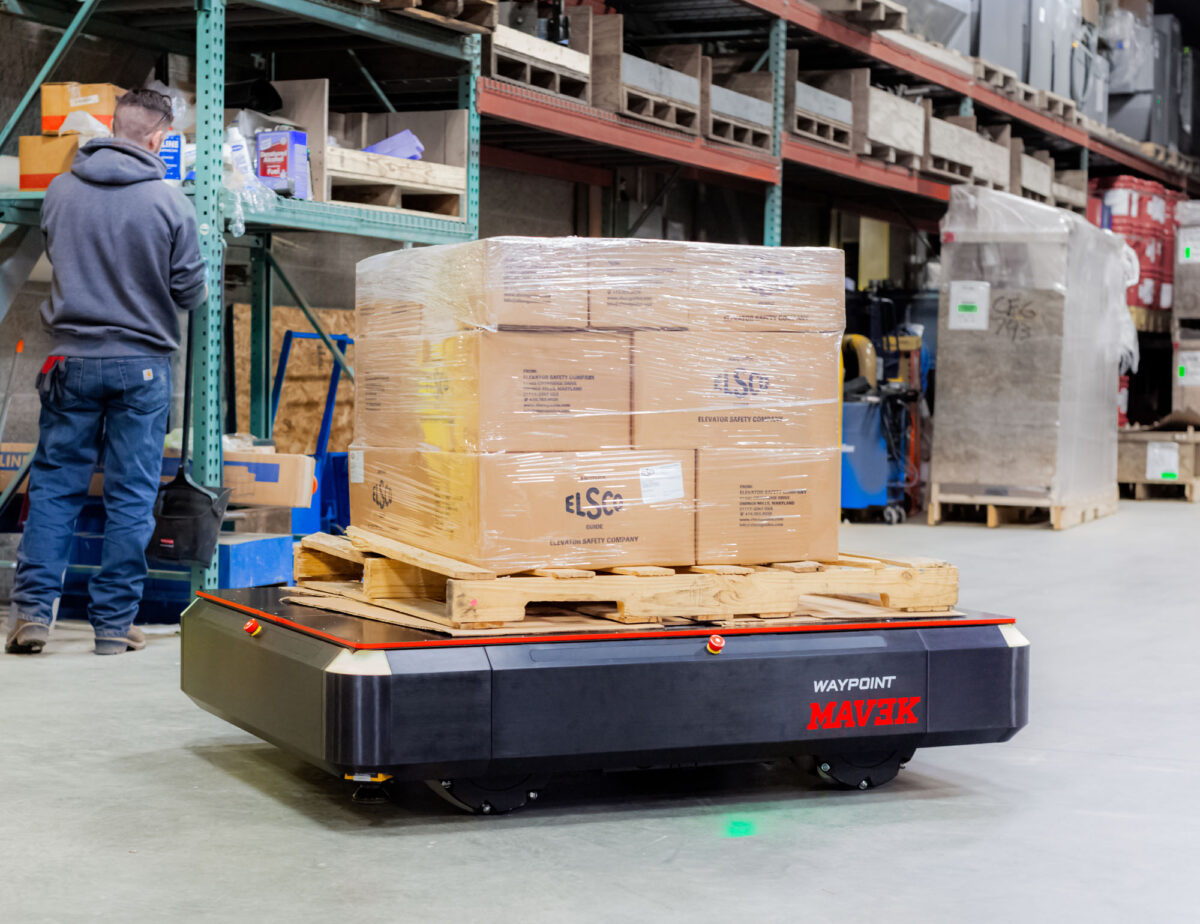
Waypoint Vector™ 3DHD autonomous mobile robot includes a 3D perception system and a 600-lb payload capacity.
Changes related to the COVID-19 crisis and the construction and surety industries are still occurring; some data in this article may have changed from the time of article submission and the publication date.
Although COVID-19 brought sudden economic hardship and unemployment to the U.S. this past spring, the construction industry remains essential—and chronically short of skilled labor. Robotics technology is on track to bring greater operational efficiencies to construction, help retain more of the best workers, and make jobsites safer.
Counted among the many impacts of COVID-19 on society and the economy has been a sharp downturn in the labor market, including that of construction. Surety professionals and contractors are well advised, however, to put the impact of coronavirus in a context that links construction’s endemic labor shortages with imperatives to increase productivity and build a more skilled workforce.
Meanwhile, one industry analyst described pent-up demand stemming from coronavirus-caused delays and shutdowns as leading to a surge in new construction activity by third-quarter 2020. That’s not to say coronavirus won’t have an effect on construction. Indeed, all industries will likely undergo a regrouping in the wake of COVID-19, with new ways of navigating uncertainties and weathering change coming to the fore.
Jason Walker, CEO and Co-Founder of Waypoint Robotics, said automation will have a role to play in that process—the coming robotic future in construction undoubtedly will help contractors do more with what they have. As a consequence, Walker said, workers will find construction jobs a better match for their skills and expectations.
What’s more, he said, they’ll find construction jobsites safer places to work.
Augmenting Workers, Not Replacing Them
Nashua, New Hampshire-based Waypoint Robotics designs and builds autonomous mobile robots (AMRs) intended to be used by workers who are already on the job, not by experts brought in from the outside. Surety producers should realize that on the horizon for contractors is a future where construction workers themselves are able to deploy AMR technology to do what they need to get done in ways that make the work faster, better, and safer.

PHOTO BY WAYPOINT ROBOTICS INC.
“We’re centered around making robotics accessible to everybody in the workforce,” Walker said. “And we do that by providing a user experience that’s above and beyond what anybody’s seen in robotics before.”
To understand what Walker means by user experience, think of a nail gun: if it were significantly more complex than the technology it was designed to replace, roofers would still be swinging hammers. “But it’s a product that’s designed to understand the work roofers do and optimized for the people who put it to work,” Walker said.
It’s also more than fair to say that there would be fewer folks willing and able to do the roofer’s job effectively if the nail gun didn’t exist. Although coronavirus has temporarily changed the conversation around labor shortages in construction, there’s no reason why the industry shouldn’t leverage opportunities as they become available. “When you’re having a hard time finding and retaining people, everything you can do to make work easier and better is going to be hugely valuable,” Walker said. “I have friends who have worked in the construction industry for their whole careers, and they can’t remember a time when there was spare labor.”
A Waypoint AMR is, therefore, delivering technology that can move materials around factories, warehouses, or construction sites in ways that are functional, intuitive, and useful to the people who are already there. “If we can go in and give people a nail gun instead of a hammer, that’s going to be good for everyone,” Walker said.
Better Work is Safer Work
Waypoint aspires not to replace workers but to perform certain task with those AMRs, for those workers. This is relevant because the ultimate question is not whether there are individuals available to fill construction roles, but whether those individuals have the experience, skill, and commitment to help firms realize their goals.
The bottom line is that there likely will never be enough good people to fill some of the more repetitive and physically demanding roles in construction. Sooner or later, committed workers are going to want something more from the work they do every day. What robotics can do, Walker said, is clear away some of construction’s more onerous tasks. Doing so invariably exposes workers to fewer hazards. “Even if you’re just moving materials around a site, it’s really, really easy to perform a simple task in a way that’s inconvenient at best or expensive and dangerous at worst,” Walker said.
Tasks involving hammer or percussive drilling are a classic example. Hammer drills use a rapid succession of short bursts to pound materials like concrete at the same time they’re being drilled. Places in construction sites where that sort of work needs to be done are generally extremely unpleasant places to be.
Imagine hanging a drop ceiling, for example; the process might involve hammer drilling hundreds or even thousands of holes into concrete at 6-foot-by-6-foot intervals. The work is arranged overhead, the drill is heavy, and the concrete dust is falling. It’s a task that’s seemingly designed to be exhausting, mistake-prone, and hard on the body. “It’s wretched; nobody wants to do that,” Walker said.
There’s also the question of whether you even want your front-line employees spending their time that way. Take installing an HVAC system on the roof of a commercial structure as another example: most scenarios inevitably involve lugging materials from where they’ve been forklifted onto the roof over to the actual work. “You just walk back and forth,” Walker said. “And maybe you’re doing it in the hot, sticky, Florida sun. Everybody involved knows that anybody who has the expertise to put in a commercial HVAC system ought not to be the person who has to move that material back and forth. But you still do it because it’s also crazy to employ a person whose only job is to move materials for a few hours a day.”

MAV3K™ AMR features an industrial-strength chassis, a 3,000-pound carrying capacity, and omnidirectional mobility.
Challenges in Jobsite Automation
All of that being said, designing and building autonomous mobile robots to handle repetitive tasks in dynamic construction environments isn’t a matter of flipping a switch. If it were, more robots would already be out there on the job.
That’s because, while getting a robot to move through a smooth and static environment like a warehouse is hard, getting it to navigate the unique complexities of a construction site is on another level—the details always differ depending on the individual application. The simple act of moving materials might seem generic, but construction environments are in constant flux.
“If you’re doing greenfield construction, and it’s a dirt lot all the time, every time, then it’s going to be tough,” Walker said. “But if you do commercial sheet rocking in malls and you’ve got to carry pallets of stuff from the delivery spot to where you’re working, that’s a pretty great place to use an autonomous mobile robot.”
Other applications where AMR is already gaining a foothold include painting, masonry, pipeline maintenance and repair, and rebar tying—”things that are repetitive and where the environment is relatively well constrained,” Walker said.
But it’s not an easy road; the challenge of expanding the robot skillset is multidisciplinary. “Robotics simultaneously involves electrical engineering and mechanical engineering and software engineering and embedded engineering, and then all of the environmental factors, and even getting into civil engineering when you start thinking about making a robot that’s going to do work in construction,” Walker said.
What it will take to continue to move forward is more partnerships between technologists and construction executives with vision. “The secret is to dream big but very narrowly,” Walker said. “Focus all your attention on one thing, do it until it’s perfected, and then repeat it and optimize it.”
Part of the problem is that the public thinks robots can do anything when in reality the sensor technology, system integration, and talent in control system development and tuning that make automation feasible require enormous effort to get right.
“If you’re doing construction and the walls haven’t gone up yet, or if it’s all glass, then maybe the robot works perfectly for six months, but all of a sudden the sun hits at just the right angle where it blinds or saturates the sensor, and the robot isn’t able to continue to function safely,” Walker said. “And so then the question is, can the robot sense that situation and keep itself and everyone around it safe?”
Building Careers in Construction
Still, the future is coming, and it bodes well for builders. AMR componentry gets better and cheaper over time, and teams already exploring the market and perhaps already doing something well in automation are in the best position to capture additional opportunities.
Safer, more rewarding workplaces can be the result, with firms setting themselves up as career destinations emerging with a competitive advantage.
“We hear a lot about the employment market,” Walker said. “If you’re somebody who is skilled in a trade, and you’re looking at two companies that do identical work, but one gives you a tool that makes all the worst tasks in the job go away while the other doesn’t, who are you going to go with? You’re going to go with the one that offers the best experience and that sends you home at the end of the day with more energy.”
Automation also promises to reduce the impact human resource limitations can have on corporate growth. “Let’s say you’re a commercial roofing company and you have to turn down a job because the project’s a year out and you’re already double booked,” Walker said. “How do you calculate the ROI on business you never even got a chance to go after because you didn’t have enough people to do it?”
We don’t yet live in a world of flying cars and robot assistants—but we’re getting there. An AMR is off-the-shelf technology for many applications, but in the construction industry the tasks robots are used for must be chosen carefully. When surety professionals sit down with their clients to contemplate the future, robotics needs to be part of the conversation.
While it’s true that change always involves risk, common sense tells us that professionalizing construction workplaces makes them less risky while also reducing operational risk. For the right professionals, there are a lot of wins stacked up in that equation.
For all its downsides, COVID-19 actually helps make that argument, because, make no mistake, there are more COVIDS in our future. Automation brings a form of future proofing, a push toward the cutting edge that positions firms to better handle everything the future brings.
“The efficiencies that might be gained are just so incredibly variable and changeable given each project,” Walker said. “If you’re in the construction industry and you have a task that you think might be good to automate, document what it is about the task that’s important, then go to a roboticist or automation expert. What defines success is the business you won’t have to turn down and whether you can give your people room to do more high-value, enjoyable tasks.”
 Surety Bond Quarterly Professionals in Surety Bonding
Surety Bond Quarterly Professionals in Surety Bonding
